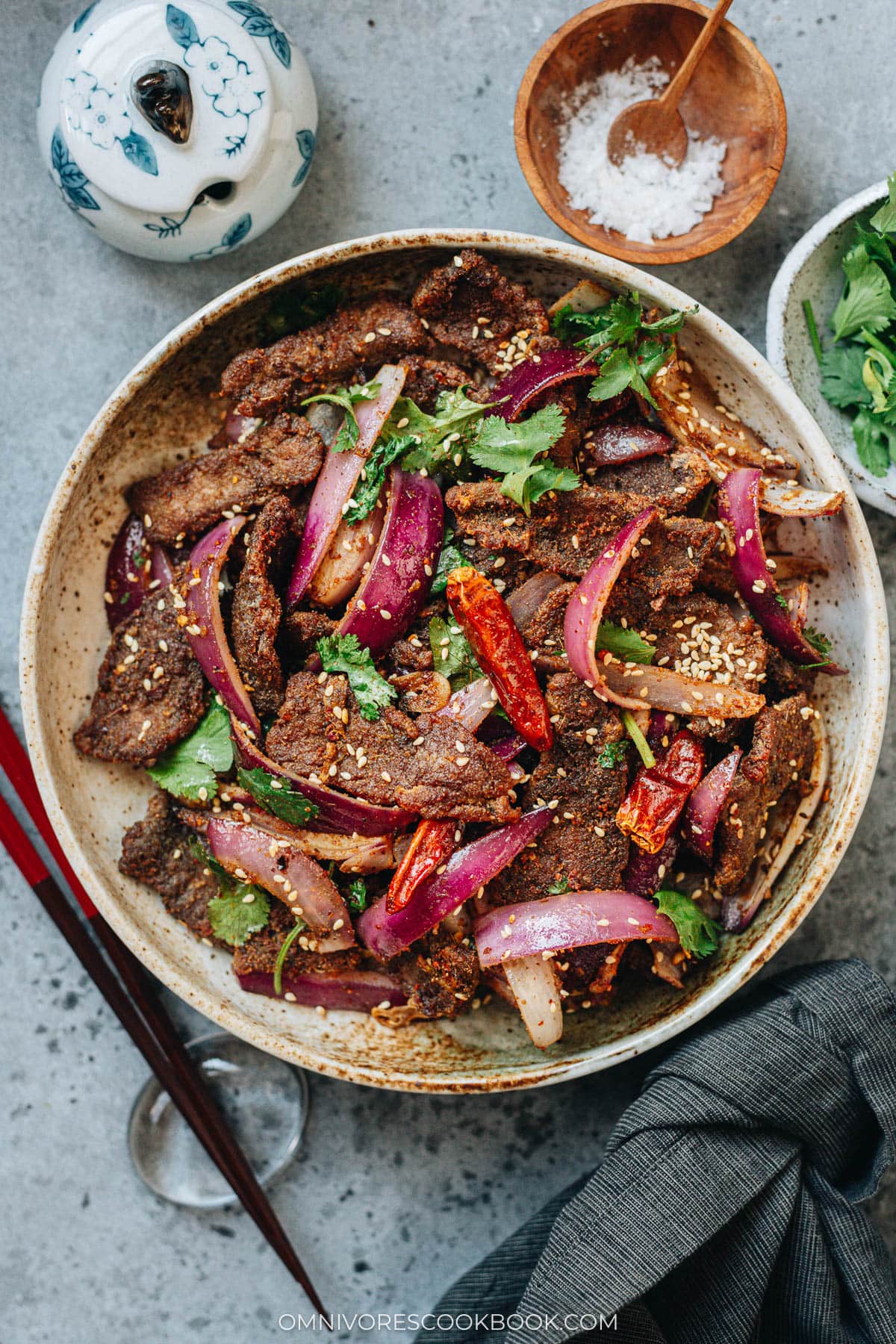
Cumin Beef, or Ziran Niurou (孜然牛肉), is a bold and fragrant dish deeply rooted in Northern Chinese cuisine. Tender strips of beef are coated in a crunchy cornstarch crust, then tossed in an aromatic mix of toasted cumin, chili flakes, and Sichuan peppercorn. Each bite delivers a crisp outer layer and a tender interior, balanced by the deep nuttiness of cumin and the warmth of dried chilies and garlic. I’ve shared my cumin lamb recipe in the past. If you like it, you can’t miss this beef version.
Unlike saucy stir-fries, this version is all about “dry stir-frying”, a technique where meat is fried until dehydrated on the surface, forming a crispy shell. It’s the same approach used in my Sichuan Crispy Beef recipe, helping to concentrate flavors and create addictively crispy textures without deep frying.
Perfect as a main dish with steamed rice, or served with flatbread and snacks on a platter, this is a crowd-pleaser for spice lovers and cumin fans alike.
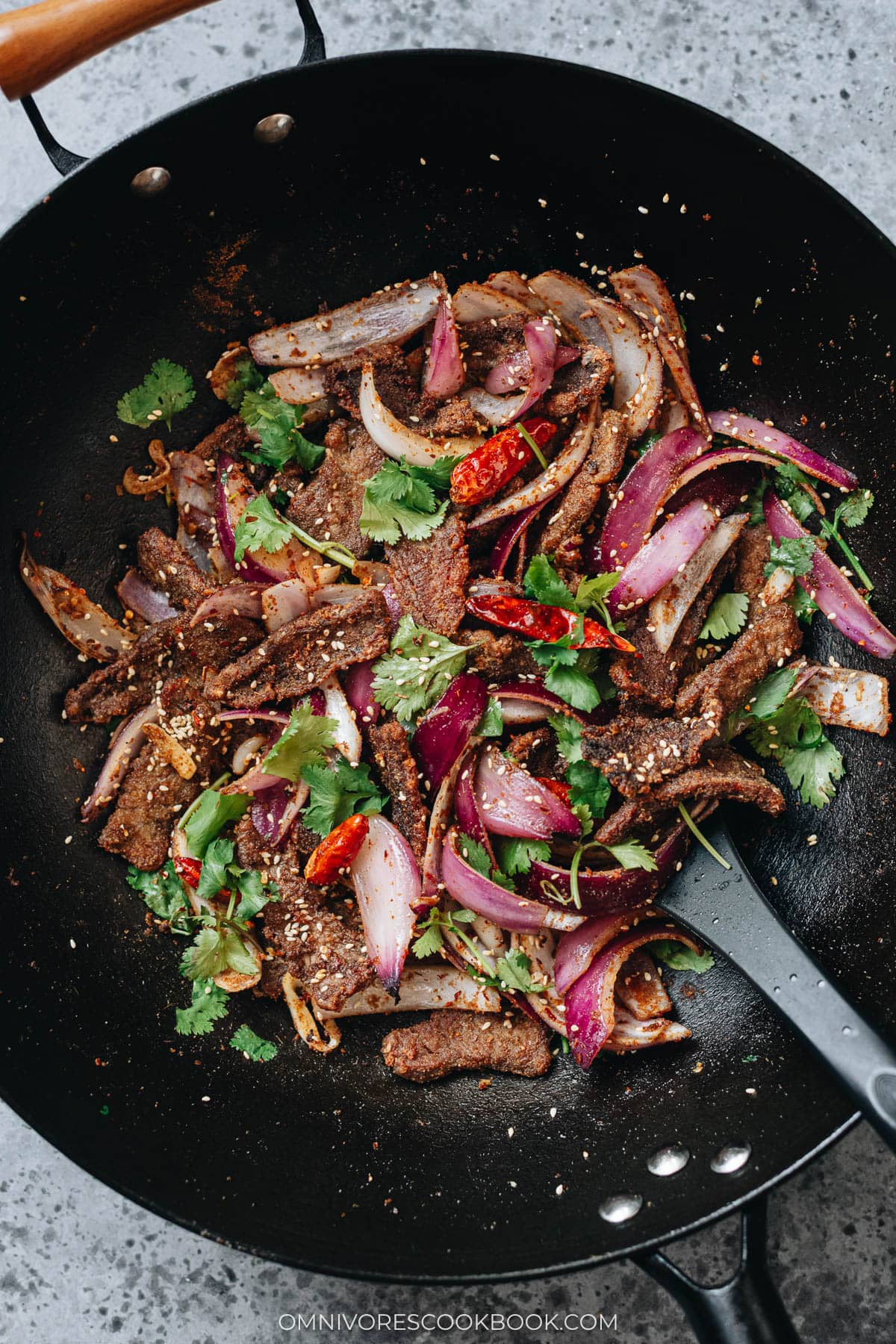
Ingredients
Cumin beef uses a few common ingredients from your pantry.
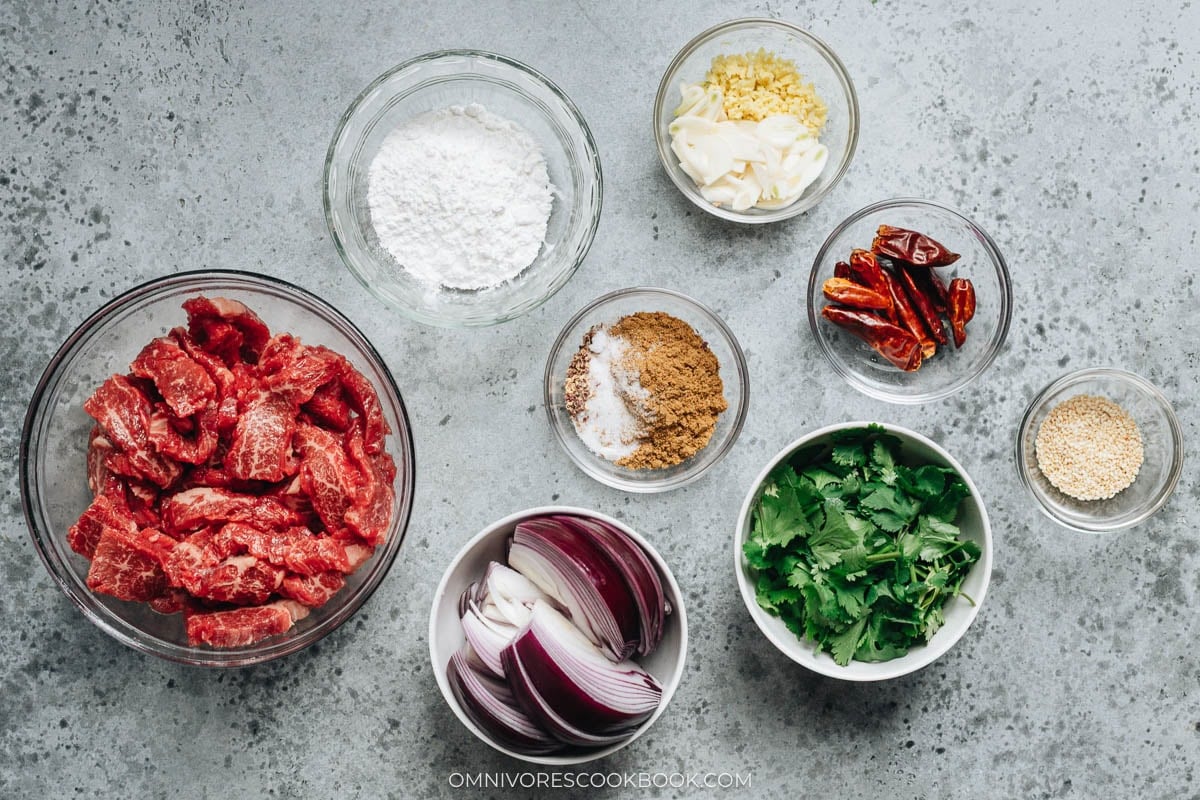
- Beef: My favorite cut for stir frying is flank steak.
- Baking soda and oil marinade: Tenderizes the beef while helping lock in juices, ensuring each bite is soft and flavorful.
- Cumin, chili flakes, Sichuan peppercorn spice mix: A balanced spice mix that is savory and spicy, with sugar as a hidden flavor to balance out the saltiness. You can adjust the heat level by increasing the amount of chili flakes.
- Cornstarch coating: Creates a crispy golden crust while keeping the inside moist.
- Ginger and garlic: Fresh aromatics are the foundation of the dish, infusing fragrance into the oil.
- Dried chili peppers: These peppers add a smokiness to the oil. You can cut them open to increase the heat level of the dish.
- Red onion: Red onion adds a natural sweetness to the dish, plus its crisp texture pairs perfectly with the beef.
- Cilantro and sesame seeds: To finish up the dish, both add color and flavor contrast.
Vegetable options
Cumin beef usually only contains onion for texture. But if you want to add more vegetables to your dish, consider using:
- Pepper – You can either use bell pepper, or hot chili pepper for some heat.
- Celery – Slice the celery thinly on the bias. It adds a great texture to the dish and pairs well with the aromatics.
- Carrot – Thinly sliced, add it at the beginning of the cooking. It adds color and a natural sweetness to the dish.
As you can see, it’s best to use hard vegetables in cumin beef. Vegetables containing a lot of moisture might release liquid during cooking and make the beef soggy.
How to make
1. Marinate the beef. I like to slice the beef a littler thicker for cumin beef, since the beef will shrink and dehydrate during cooking. First, marinate the beef with baking soda to tenderize it, then coat it with cornstarch right before cooking. Use your hands to thoroughly mix the beef, so it gets coated evenly.
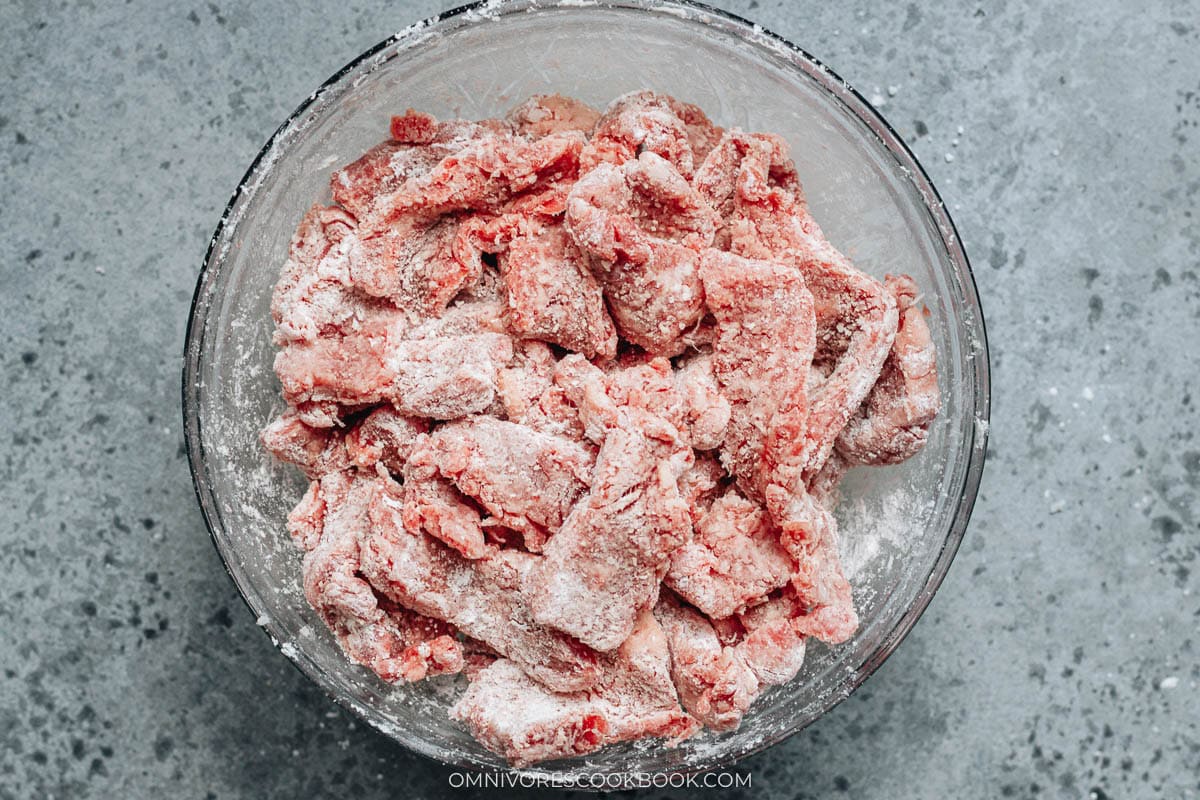
2. Fry the beef until crispy. This step takes a little longer than your usual beef stir fry. Instead of searing the beef until just cooked through, you want to cook it long enough that the surface gets very crispy. Since we use baking soda to tenderize the beef, it will remain tender on the inside. You should cook the beef in batches so the beef can be spread out without overlapping.
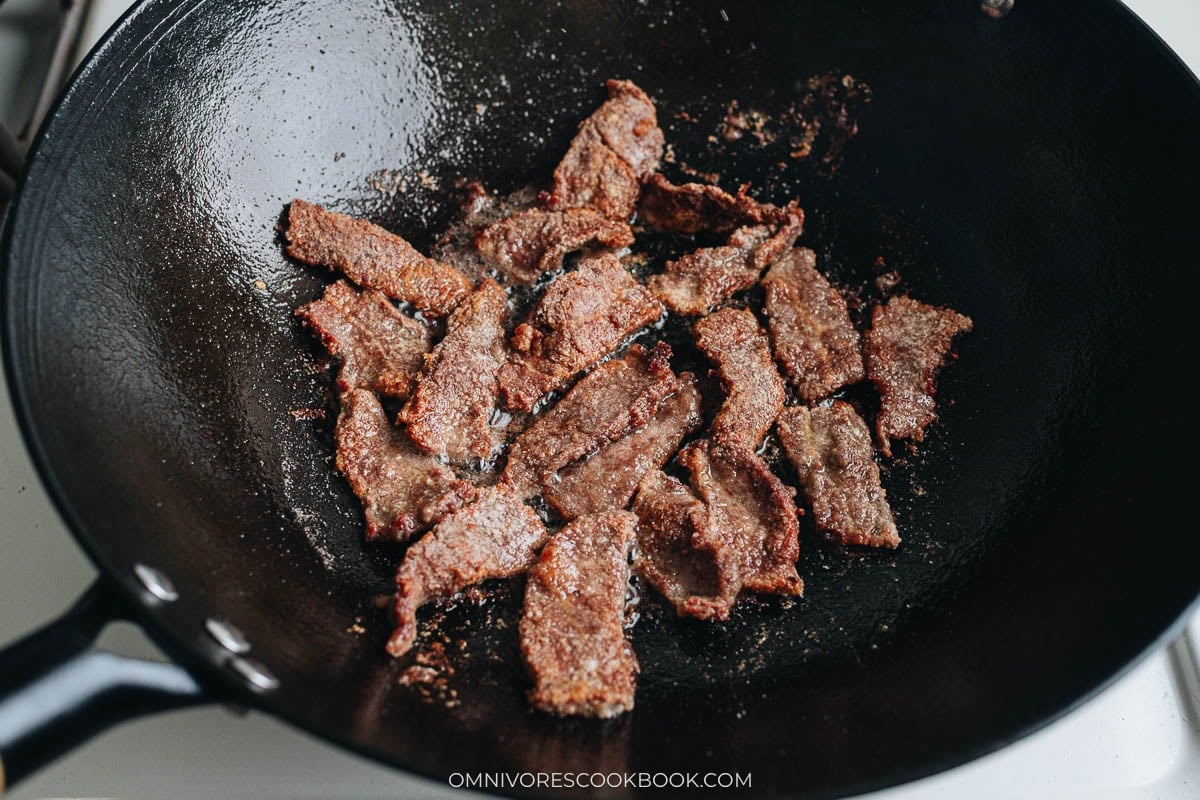
3. Take out the beef so it cools off a bit. I also like to use tempura paper (folded paper towels also work) to further soak up excess oil from the beef, crisping up the texture even more.

4. Saute the onion, then the aromatics. I like to cook the onion very briefly so it’s still crisp. If you like a more tender texture, cook the onion longer.
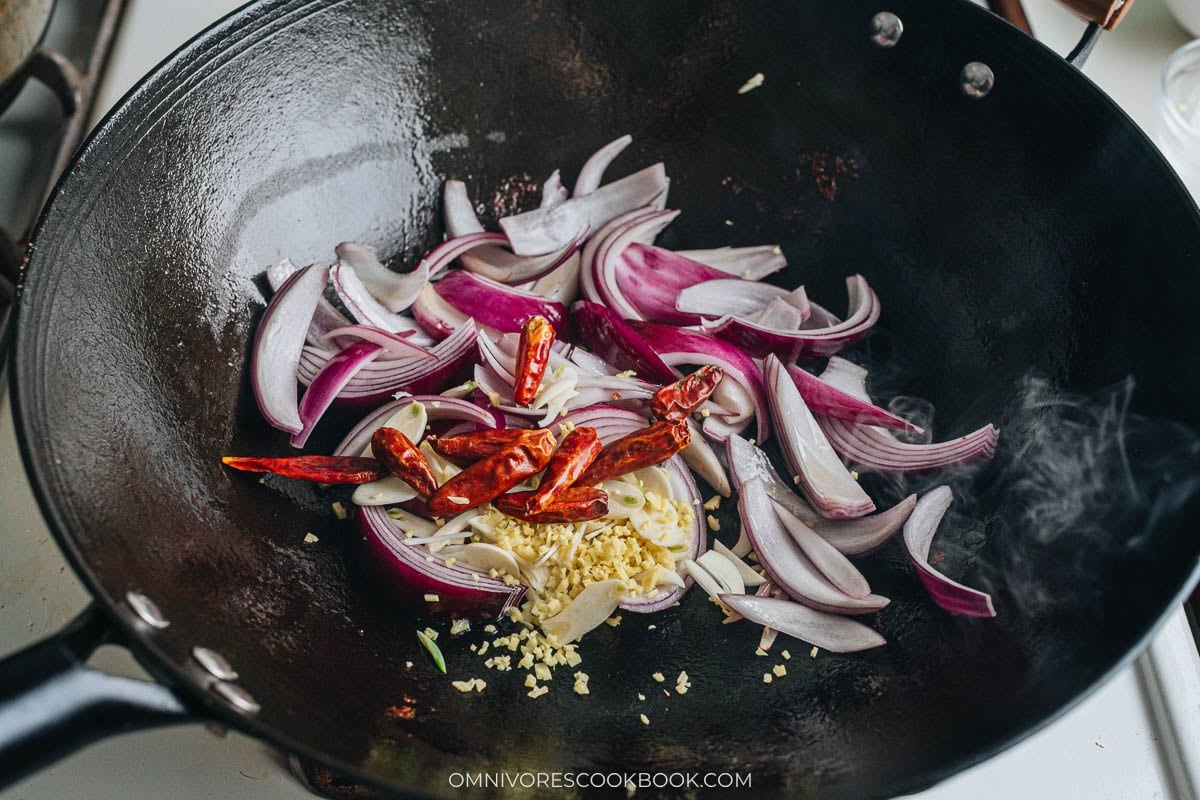
5. Add back the beef and add the spice mix. Give the beef a good toss so every piece is coated evenly with the seasonings.
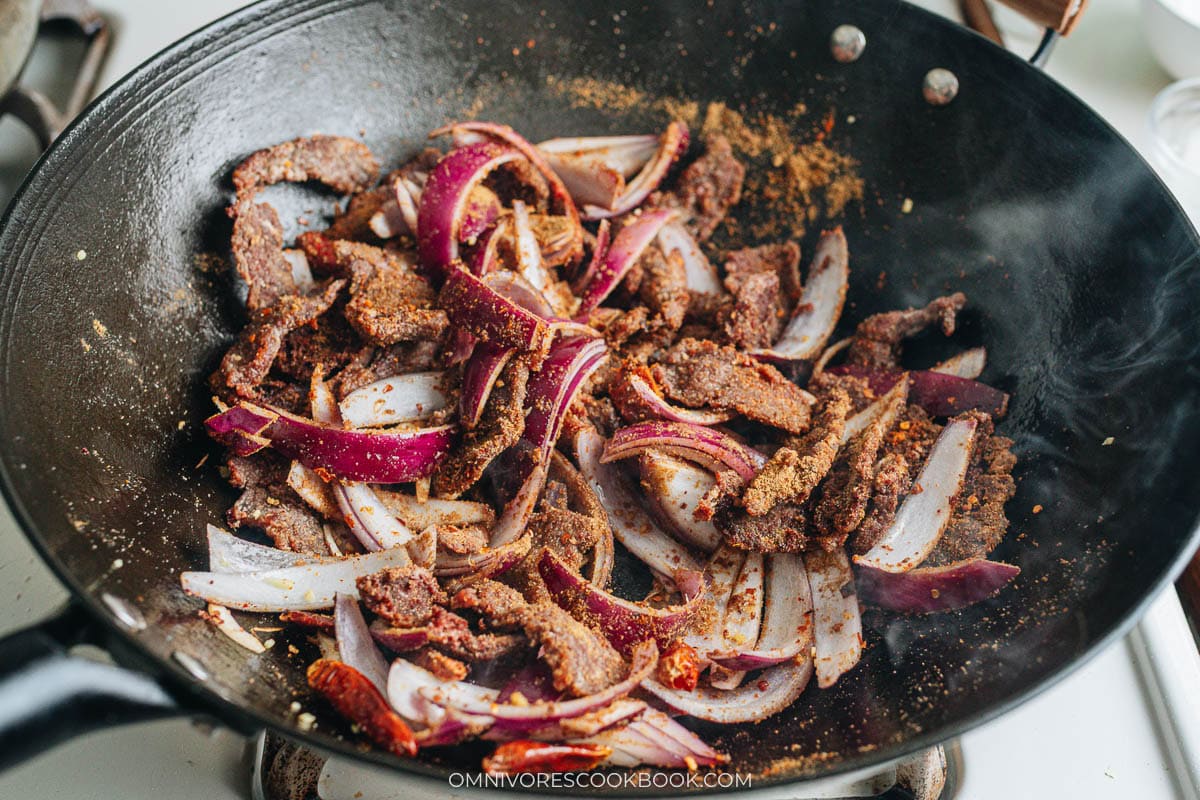
6. Lastly, finish up the dish by adding sesame seeds and cilantro.
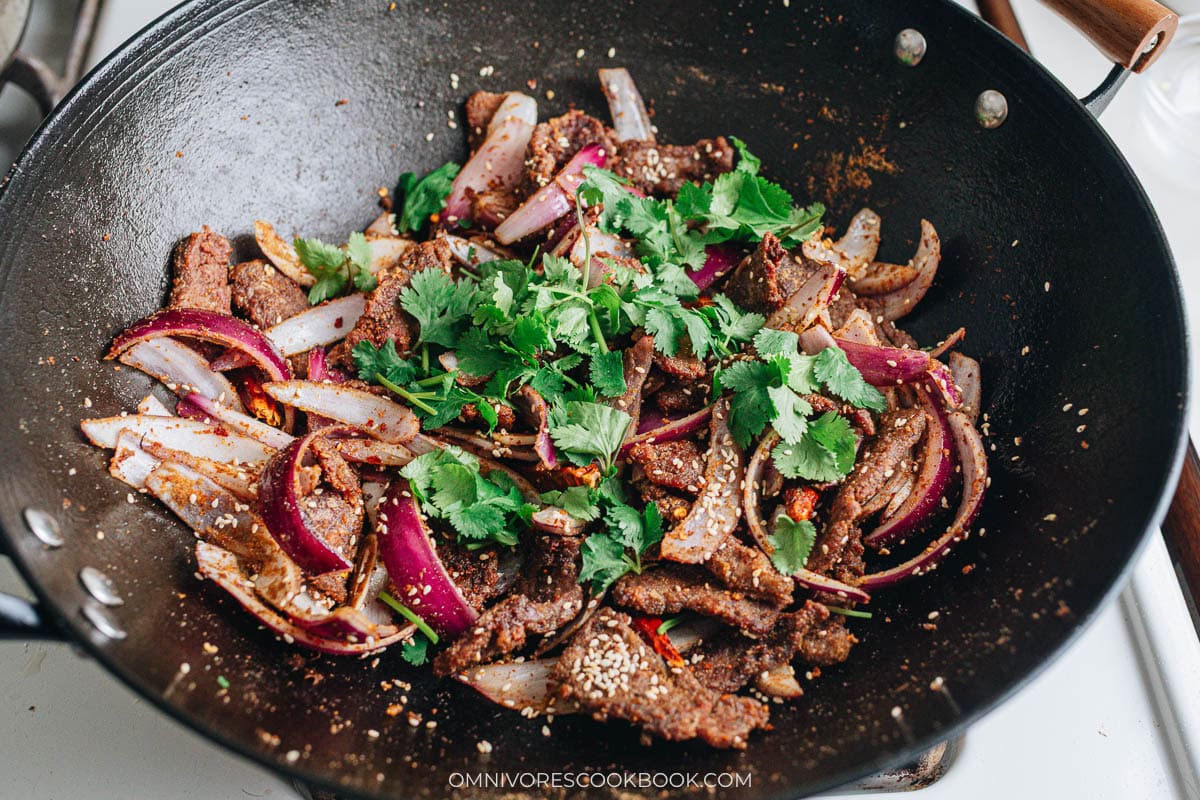
How to serve
Serve cumin beef with steamed rice or flatbread for a quick meal. For a full dinner, consider adding a simple green side dish such as garlic green beans or Chinese coleslaw. Soup is always a good side dish to add texture. Make some spinach egg drop soup or napa cabbage and tofu soup to add color to your meal. In the summer, ice cold beer is always a great drink to serve on the side to wash down your food.
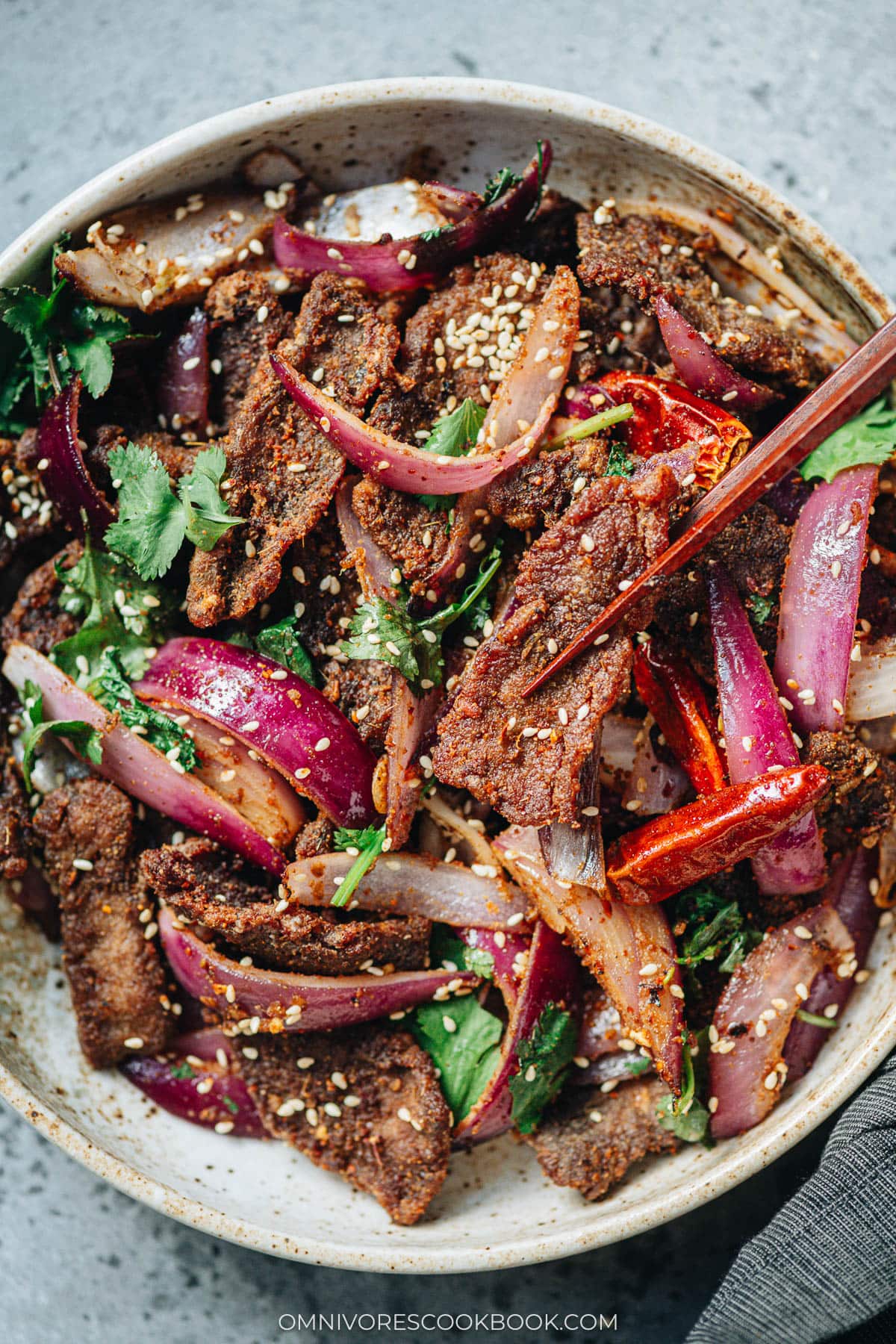
Frequently asked questions
Can I use a different cut of beef?
Yes. Flank steak works best due to its lean texture and ability to hold up well to high-heat cooking. However, you can also use skirt steak, flat iron, or even sirloin as alternatives. This recipe uses baking soda to tenderize the beef, so other beef cuts will work well here.
How to adjust the spice level of the dish?
For less heat, reduce the amount of dried chilies and chili flakes. You can use mild Korean chili flakes (gochugaru) or even sweet paprika to keep the color without the heat. For a spicier dish, cut the peppers to reveal the seeds, and use the seeds in the dish. You can add more chili flakes into the spice mix. Or add a splash of chili oil or chili crisp at the end of the cooking to further spice it up.
Can I skip the cornstarch coating?
It’s not recommended, but still possible. The cornstarch is key to achieving the irresistible crispy texture of the beef while locking in moisture. Without it, you’ll need to cook the beef longer so the beef dehydrates enough to achieve a crispy texture. The beef will lose a lot of moisture and fat and shrink a lot, and the texture will be chewy and similar to beef jerky.
Chinese Cooking Made Easy
Are you new to this website? This free email series is a great place to start. I’ll walk you through a few of my most popular recipes and show you how and why they work. You’ll quickly start to cook better Chinese food in your own kitchen.
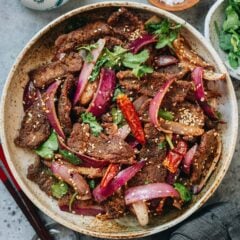
Cumin Beef (孜然牛肉)
Ingredients
- 1 lb beef flank steak
- 1/4 teaspoon salt
- 1/2 teaspoon baking soda
- 1 tablespoon vegetable oil
Spice mix
- 2 tablespoons cumin powder
- 2 teaspoons Sichuan chili flakes (or Korean chili flakes)
- 1/2 teaspoon sugar
- 1/4 teaspoon freshly ground Sichuan peppercorns (or black pepper)
- 1/4 teaspoon salt
Stir fry
- 1/4 cup cornstarch
- 3 tablespoons peanut oil (or vegetable oil)
- 8 dried Chinese chili peppers , halved crosswise and seeds removed
- 1 small red onion , sliced into 1/2” (1 cm) thick pieces
- 1 tablespoon ginger , minced
- 5 cloves garlic , sliced
- 1 tablespoon toasted white sesame seeds (for garnish)
Instructions
- Cut the flank steak along the grain into two even pieces, then slice it against the grain into pieces that are around 1/4” (5 mm) thick.
- Combine beef, salt, baking soda and vegetable oil in a big bowl. Mix well. Let marinate for 30 minutes at room temperature.
- Combine the ingredients for the spice mix in a small bowl.
- When you’re ready to cook, drain the extra liquid from the bowl of beef. Add the cornstarch, a few tablespoons at a time, and mix, until all pieces are coated.
- Heat 2 tablespoons of oil in a wok or large skillet over medium-high heat until hot. Cook in batches, spreading the beef slices without overlapping. Cook until the bottom turns golden and crispy, 2 to 3 minutes. Flip the slices to fry the other side, until golden brown and crispy, another 1 to 2 minutes. (*Footnote 1) Transfer the beef to a large plate. Cook the rest of the batches. Add more oil if the pan gets dry, and turn to medium heat if the pan starts to smoke too much.
- Add the remaining 1 tablespoon oil, the dried Chinese chili peppers, ginger, and garlic. Stir a few times to release the fragrance. Add the onion. Stir and cook for about 1 minute, until the onion just starts to turn tender. Add back the beef and sprinkle the spice mix all over. Stir immediately to coat the meat with spice. Remove the pan from the stove and carefully taste a piece of beef. Sprinkle a bit more salt on it, if needed. Turn off the heat. Add the sesame seeds and cilantro. Stir again. Transfer everything to a big plate immediately. Serve hot as a main dish.
Notes
- When the beef is pan fried, the cornstarch will become light golden first. Then you will notice some of the pieces turning dark brown. That means the beef surface is fully dehydrated, and will form a crispy chewy texture. Aim to create this texture on some of the pieces, but not all the surfaces. So the inside of the beef will remain juicy and tender.
Nutrition

Did you make this recipe?
I’d love to hear how it turned out for you! Please take a moment to leave a 5-star rating ⭐️ and share your thoughts in the comments further down the page. It really helps others discover the recipe too.

Thomas
Wow, deeply flavorful. I toasted the cumin seeds before grinding them. Do you do that? I look forward to making this again soon. Thank you!
Maggie Zhu
That sounds awesome. I used cumin powder so I didn’t toast them. But yeah, toasting cumin seeds and grinding is the best way to go 🙂
Cathy
Wow! So good and so easy to make. I made it for my daughter for her birthday and she loved it. Even asked for the website for other recipes! And it came together in less than an hour, including the 30 minutes marinating time. Just terrific. Thank you!
Bill K
Just completed our fall lamb butchering today so we’ve got a lot of lamb, not so much beef. We raise hair sheep so the taste of the meat doesn’t have any of the gamey or greasy characteristics so many people complain about when they think of lamb
Do think beef recipes, like the ones you’ve got listed on this page would make a tasty transition to lamb?
Maggie Zhu
I think you definitely can.
Alternatively, you can also directly use my cumin lamb recipe: https://omnivorescookbook.com/cumin-lamb/
It cuts the lamb differently. Also, I used a different slicing method for the lamb so I can keep it more tender since I didn’t use baking soda in the recipe.